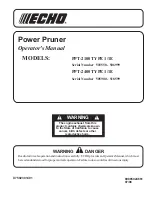
22
22
Arm Lift Retention
Refer to Figure 22.
If arm will not remain in position after being raised,
loosen hex nut (14mm wrench), and slightly turn
adjustment screw clockwise with flat blade
screwdriver, until arm remains in raised position.
Do
not overtighten
. Tighten hex nut.
Figure 22: Tightening Arm Lift
Blower Nozzle
Adjust blower nozzle away from operator, and as close
to blade as needed without interfering with blade or
workpiece movement.
Operations
General Operating Tips
1. Always use a clean, sharp blade.
2. Maintain proper posture to avoid strain. Saw table
should be set approximately level with operator’s
elbows.
3. Avoid wrist or finger strain which can occur by
constantly pushing workpiece against table.
Always use hold-down whenever possible.
4. Guide the wood into the blade slowly to prevent
blade breakage.
5. You will achieve best results when cutting wood
less than 1-inch thick. When cutting stock thicker
than 1-inch, guide the stock very slowly into the
blade, taking care not to bend or twist the blade.
6. Blade should have minimum 3 teeth in contact with
workpiece at all times.
7. Make relief cuts as needed to prevent binding of
blade in workpiece.
8. A blade has a tendency to follow the wood grain.
Be prepared to compensate for this to achieve
accurate cuts.
9. Use caution when sawing round pieces, such as
dowels, which tend to roll while cutting.
10. Keep fingers away from cutting path. Avoid
awkward hand positions or getting fingers wedged
between saw arm and workpiece when cutting
small workpieces.
11. For fretwork, drill all needed pilot holes at the
same time before moving to the scroll saw. Drill
pilot holes as close as possible to reference lines.
12. As a general rule, select the narrowest blades
recommended for intricate curve cutting, and
widest blades for straight cuts or large curve cuts.
13. Run saw only at high enough speed to efficiently
do the work. Constant running at maximum speed
is not necessary for most operations, may reduce
control of the cutting process, and may hasten
wear on the saw.
On/Off Controls
With foot pedal:
Push on/off switch to ON position (I).
Press foot pedal to operate saw, release pedal to stop.
Without foot pedal:
Push on/off switch to ON position
(I); saw will operate. Press switch to OFF position (O)
to stop.
If foot pedal is not used and power
outage occurs during operation, blade will resume
motion when power is restored. Turn off switch
immediately after power outage to avoid
accidental restart.
Procedure
1. Install blade appropriate for desired operation.
Make sure blade is properly tensioned, and teeth
point forward and down toward table.
2. Position blower nozzle and hold-down.
For straight cutting or outside curve cutting:
3. Turn on saw and allow blade to reach full
operating speed.
4. Set speed using variable control knob.
5. Hold workpiece firmly against table and feed
workpiece directly into front edge of blade with
steady pressure. See Figures 23 and 24. Do not
use excessive pressure – allow the blade to do the
work. Compensate for blade drift.
















































